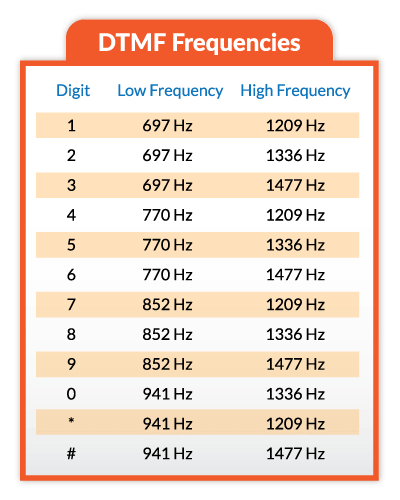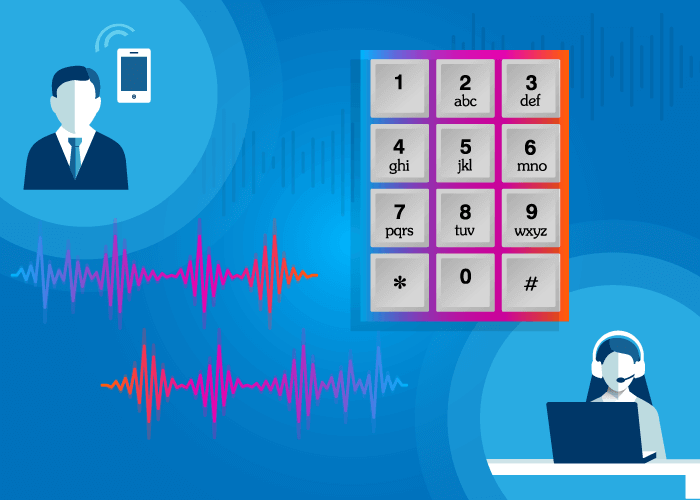In this post, we explain what dual-tone multi-frequency, or DTMF, is and how it is central to voice calling. This is a telecommunications technology that works under or inside your phone system. So, it is not an extra feature but should come with your phone service.
What is Dual-Tone Multi-Frequency?
When you press a number key, DTMF sends the following:
- signal to your phone company indicating that you want to make a call and
- command to the switch.
And it does this by sending two tones – a high- and low-frequency tone – for every number key pressed.
You can learn more about the history and evolution of DTMF here.
How Does DTMF Work?
The dual-tone multi-frequency technology assigns 8 different audio frequencies to the rows and columns of a keypad. The columns have high-frequency signals, and the rows have low-frequency signals. Here’s what that looks something like this:

When a user presses a key (number or symbol), a tone generates by combining the high and low frequency of the number. For example, when you press the number ‘7,’ frequencies 852 Hz and 1209 Hz are combined.
The DTMF technology then sends this combined signal over phone wires to the local phone exchange. Once there, the exchange decodes the signals to determine the entire number the user wants to call. Once identified, the call automatically routes to the desired number and destination.

What is DTMF Used for? Common Use Cases
Besides ensuring that your dialed numbers actually place calls, DTMF technology has revolutionized the way users interact with an outgoing call. For this reason, this technology has many benefits for businesses and contact centers with high call volumes. Let’s look at some use cases:
Navigational Tool
The most common use case for dual-tone multi-frequency technology is its influence on interactive voice response systems (IVR). IVR is an automated call handling system that answers incoming calls, interacts with callers, and directs them to their destination.
DTMF tones are the dominant signaling protocol for interacting with an IVR. An IVR typically provides users with menu options such as Press 1 for Sales, Press 2 for Billing, etc. With DTMF technology, callers simply press a number key to be routed to the desired department.
Information Entering Tool
Another way to use DTMF tones is to let callers input (or dial in) numbers to verify their identity.
For example, they could input their account number, the last 4 digits of their card, their order number, and so on. Then, the auto-attendant or agent can use this information to help them faster.
In some cases, the IVR can collect information before the agent joins the call. In other instances, the auto-attendant may just provide the caller with the necessary response. Such as the familiar: You have a pending balance of $XX; would you like to pay now?
Self-Service Options
Finally, you can also use dual-tone multi-frequency technology to let calls complete certain actions, like:
- Changing language preferences
- Make or confirm bookings or reservations
- Checking bank or bill balances
- Filling out phone surveys, etc.
Using DTMF Tones with United World Telecom
United World Telecom provides DTMF with our Advanced IVR feature for both IVR menu and input options.
As you build out your phone system within our IVR editor, you can assign departments and agents to different numbers. Callers can then press those numbers on the keypad or enter specific extensions and codes to reach their desired department.
However you want to design your business’ call flow, our voice solutions are here to help! Call us at 1 (877) 898 8646 or chat with us online!

